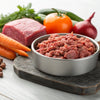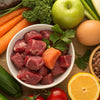How to Get Your Dog to Eat Raw Food: Tips for a Seamless Transition
- Houndsy
Table of Contents
- Introduction
- Understanding Your Dog's Hesitation
- Practical Strategies to Encourage Your Dog to Eat Raw Food
- The Benefits of Feeding Your Dog a Raw Food Diet
- Conclusion
- FAQ Section
Introduction
Imagine standing in your kitchen, eagerly preparing a delicious and nutritious raw meal for your beloved dog, thinking of all the benefits this new diet will bring. But when you place the sumptuous bowl in front of your furry friend, they glance curiously at the raw meat, sniff it, and promptly walk away. If this scenario sounds familiar, you're not alone. Many dedicated dog owners experience hesitation from their pets when introducing a raw food diet. According to a survey, nearly 40% of pet owners report challenges when transitioning their dogs to raw food, often questioning their decision and worrying about their dog’s nutrition.
Transitioning a dog from kibble to raw food is not just a dietary change but also a significant lifestyle shift. The appeal of a raw diet is compelling—less processed ingredients, more natural nutrition, and even improved health outcomes. However, many dogs are set in their feeding routines, influenced by the taste, texture, and aroma of the kibble they have come to know. In this blog post, we will explore various methods for encouraging your dog to embrace a raw food diet, drawing on practical advice, insights, and our own experiences as pet owners.
Our mission is to empower you as a pet parent to make informed choices that positively impact your dog’s health and wellness. By the end of this article, you will not only learn effective strategies on how to get your dog to eat raw food but also understand the underlying reasons some dogs resist such a transition. We will cover tips, tricks, and the incredible benefits of choosing a raw diet for your furry companion.
Understanding Your Dog's Hesitation
Before we delve into strategies for encouraging your dog to eat raw food, it's essential to understand why some dogs may reject it. Here are three primary reasons:
1. Change in Familiarity
Dogs are creatures of habit, often relying on the familiarity of their routine. If your dog has been eating kibble for years, the change in diet can be confusing. Just as we might resist trying a new dish, dogs may need time to warm up to a raw diet.
2. Flavor and Texture Preferences
The taste and texture of raw food differ significantly from kibble. Kibble is often designed to be flavorful and appealing, with added fats and preservatives to entice your dog. On the other hand, raw food, while nutrient-rich, may not have the same level of palatability, especially if your dog is used to the artificial flavors found in commercial pet food.
3. Instinctual Behavior
Interestingly, some dogs may instinctively hesitate when presented with raw meat. Even though dogs are natural carnivores, their individual preferences can play a significant role in their willingness to accept a new diet. For instance, some dogs may feel that the change from served kibble to raw meat is a deviation from their understanding of what food should look and smell like.
Understanding these factors is critical; knowing your dog's behavior allows you to strategize effectively and creatively to change their eating habits.
Practical Strategies to Encourage Your Dog to Eat Raw Food
Now that we have a grasp on why dogs may resist raw food, let's examine some practical strategies for making the switch smoother:
1. Gradual Introduction
Instead of completely switching your dog to a raw diet overnight, introduce it gradually. Mixing small amounts of raw food with their regular kibble can ease the transition. Start by adding just a teaspoon of raw food to their bowl, gradually increasing the amount over a week or more.
2. Incorporate Flavors They Love
Adding flavors or ingredients that your dog already enjoys can entice them to try raw food. Consider mixing in a small amount of bone broth, cooked meat, or a sprinkle of their favorite treats on top of the raw food. This can make the unfamiliar more appealing.
3. Experiment with Different Proteins
Dogs can have preferences for certain protein sources. If your dog is hesitant to try chicken, for example, switch to beef or even turkey. Explore various proteins like rabbit, lamb, or fish to see if your dog exhibits a taste for one over the others.
4. Check the Temperature
Sometimes, the temperature of the food can play a significant role in your dog’s willingness to eat. Some dogs prefer their food at room temperature, while others might be more inclined to eat slightly warmed food. Avoid using the microwave, as this can cook the food. Instead, let it sit out for a few minutes or add warm water to enhance the aroma.
5. Create an Engaging Eating Environment
Transform mealtime into a more engaging experience by making the food appear as a "reward." You can hide the raw food inside a puzzle toy or a slow feeder designed to stimulate your dog's interest and give them something to work for.
6. Make It A Treat
If your dog struggles to eat the raw meal directly, try feeding it to them as a treat. Offer small portions on a spoon or let them sample it from your hand. By turning raw food into a special reward, it can help shift their perception.
7. Be Patient and Consistent
It's crucial to remain patient during this transition. If your dog refuses to eat raw food, remove the bowl after about 20 minutes, then try again at the next meal. Dogs can be stubborn, but they usually will eat when they are hungry. Create a consistent feeding schedule that incorporates raw food into their routine.
8. Incorporate Raw Goat Milk
Raw goat milk is a fantastic option for many dogs, as it is easier to digest compared to cow’s milk. Adding a small amount of raw goat milk over your dog's raw food can help entice them to try it. The creamy texture and aroma can make raw food more enticing.
9. Check Food Freshness and Quality
Always ensure that the raw food is of high quality and fresh. Dogs can be deterred by the smell of food that may be off or not stored correctly. Stick to reputable brands and consider the storage methods of raw food to maintain its freshness and appeal.
10. Lead By Example
Sometimes, acting like the raw food is delicious can pique your dog’s interest. Pretend to eat the food yourself in front of your dog and enthusiastically show them how much you enjoy it. Dogs learn by observation, and if they think you are excited about it, they may want to try it too.
The Benefits of Feeding Your Dog a Raw Food Diet
Transitioning to a raw food diet for your dog is not just about what they will eat; it's about the numerous benefits that come along with it. Here are some of the most compelling reasons to choose a raw diet:
1. Improved Digestion
Raw diets often lead to more efficient digestion and better nutrient absorption. High moisture content and the absence of the filler ingredients commonly found in kibble can improve overall digestion.
2. Healthier Coat and Skin
Dogs on raw diets generally exhibit a shinier coat and healthier skin. The nutrients derived from raw meat and organ meats promote a thick, lustrous coat, reducing itching and skin irritations.
3. Enhanced Energy Levels
Providing dogs with raw food can lead to increased energy levels. The natural sources of nutrients can promote overall vitality, encouraging a more active lifestyle.
4. Better Dental Health
Chewing raw meat and bones can help maintain dental hygiene by reducing plaque buildup. The mechanical action of chewing promotes stronger teeth and better oral health.
5. Weight Management
Raw diets can assist in managing a healthy weight since they often are lower in carbohydrates and fillers compared to kibble. Providing a balanced raw food diet can reduce the risk of obesity.
6. Reduced Allergies and Sensitivities
Many dogs have food sensitivities or allergies connected to common kibble ingredients. A raw diet allows owners to tailor their dog’s meals to avoid known allergens and helps identify unique foods that suit their pet best.
Conclusion
Transitioning your dog to a raw food diet can be a nuanced process that requires patience, creativity, and understanding. By employing the strategies we've discussed—from gradually introducing raw food and enticing flavors to maintaining consistency and being present—you're setting the stage for your dog to embrace a healthier, more natural diet.
As dog owners ourselves, we resonate with the challenges, and we firmly believe in the power of empowering pet parents through informed choices that promote better well-being for their fur babies. Remember, while the journey may occasionally come with bumps, the long-term health benefits for your dog will be worth the effort.
Lastly, if you’re looking for ways to enhance your dog feeding routine further, explore how the Houndsy Kibble Dispenser can simplify your mealtimes while maintaining elegance in your kitchen.
FAQ Section
Q: How long will it take my dog to adjust to a raw food diet? A: Every dog is different, but most dogs can take anywhere from a few days to several weeks to adjust to a raw food diet. Patience is essential, as gradual transitions work best.
Q: How do I ensure my dog is getting a balanced raw diet? A: A balanced raw diet should include a mix of muscle meat, organ meats, and bones. Consult with a veterinarian or a pet nutritionist to determine the right proportion and combinations for your pup.
Q: Can a dog eat all types of raw meat? A: Most meats are suitable for dogs, but it’s essential to avoid certain types like pork, which can carry risks of parasites. Always choose high-quality meat and consult a vet for specific recommendations.
Q: What additional supplements or foods can I include with a raw diet? A: Consider adding certain vegetables, fruits, and supplements like fish oil for omega-3 fatty acids and probiotics for a healthy gut. Always check with your vet for tailored recommendations.
Q: What if my dog still refuses to eat raw food after trying these tips? A: If your dog continues to reject raw food, consider consulting your veterinarian. They can help identify underlying issues and may provide insights into alternative, nutritionally adequate diets.












